Short version of the review: a few teething problems aside, we all had a wonderful time and we’d certainly consider a Daggerville game for our next murder mystery party. The characters were, on the whole, wonderful characters well-realised and fully-developed within the constraints of the genre, the twist was clever, there were moments of great hilarity (such as the point when we realised that there’d been a veritable conga-line of people stealthily following one another around the hotel), and the event built up to a fun and satisfying conclusion. I’d suggest that you all keep an eye on Daggerville in the future.
As implied earlier this week, this weekend Ruth, JTA and I had planned to host the latest in a long series of murder mystery party nights (a handful of which have been reviewed on this blog). Despite our earlier worries, we eventually filled the “missing” slots in our party with our friends Liz and Dean: exactly the couple we’d planned to fill it with in the first place, but they’d been painfully slow at RSVPing.
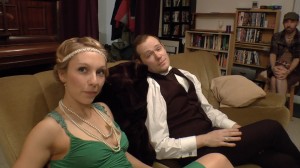
We’ve played a lot of murder mystery games over the years: we could probably be described as connoisseurs of the genre, and that might be worth bearing in mind when you read what we had to say about this particular event. To enumerate, there’s been:
- The entire back catalogue of Paul Lamond‘s Murder a la Carte / Inspector McClue series
- Several of D’Avekki Studios‘ Murder Mystery Party series
- A game in which nobody was murdered by Freeform Games
- And several murder mystery games that I’ve written: one in a “scripted” style, the rest in an “open” style
That said, this latest party really had the opportunity to cross the board, with Liz and Dean having never been to a murder mystery night before and (other) Liz and Simon having been to only a few. And to top it all off, we were working with a completely new game from a creator of whom we’d had no experience. What could be more exciting?

You see: I was contacted a little over two months ago, via my web form, by a Martin from Daggerville Games, a new murder mystery party provider of the “buy-and-download” variety. Upon visiting their website, I was immediately struck by some of the similarities between their signup form (which asks for player names to be associated with characters, genders to be chosen for characters whose gender can be selected based on the gender balance among the players, and email addresses to which invitations will be sent) and a prototype one of my own design, used in the construction of my upcoming games Murder at the Glam Rock Concert and Murder on the Social Network, the first of which we hope to host in about a year’s time. I mentioned this to Martin, in the hope that they won’t think I’m ripping them off if I eventually put some of my pieces online for the world to play, too.
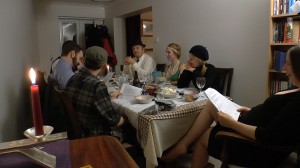
The Daggerville folks, perhaps anticipating that I would be likely to blog about the event in hindsight and thus provide them with some free publicity, offered me a voucher for a free game of my choice, which I accepted. After a little discussion, we settled upon The Ambassador’s Notebook, a 7-player murder mystery set in a rural 1920s hotel and revolving around the untimely death of a Mr. Sullivan, presumably related to a valuable journal that was in his possession.

In order to keep the spoilers at the tail end of this blog post (there’ll be a nice big warning before you get to them, so you can refrain from reading them if you’re planning to someday play this game yourself), I’ll cut to the chase and first provide a summary of the night as a whole.
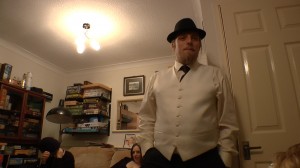
We all had a fun time: as usual for these gatherings, there was good wine, great company, and spectacular food (Ruth had, once again, put together a wonderfully thought-out and
thematically-sound menu): honestly, under these conditions we’d be pretty-much guaranteed a good night no matter what. The murder mystery itself was a scripted affair similar to those
you’ll find in any off-the-shelf kit, but with a few quirks. For a start, as hinted above, everybody gets their fragments of the script (along with dialogue entry and exit cues) very
early on: it’s possible, permitted, and even encouraged that players read their script before they arrive for the event. Some of us were concerned that this might result in
“spoilers”, and a few of those of us who did pre-read our scripts said that they regretted doing so, so be aware: it’s a spoiler-risk.
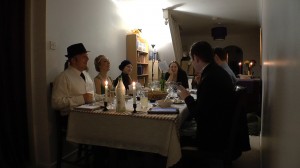
Unlike similar-styled games, though, players aren’t given additional information outside of the script, and we all felt that this made things challenging when it came to the discussion breaks. All that we had to go on for our deliberations was exactly what we’d all heard, just minutes before, tempered by our own speculation. Sometimes somebody would ask, or consider asking, a valid question after somebody’s whereabouts, alibi, or history, but no answer was forthcoming because all that we had, collectively, was the script. This caused additional confusion when, for example, Liz’s character mentioned JTA’s character by his first name, it was a surprise to everybody… even JTA, who had no idea to begin with that it was supposed to be his name!
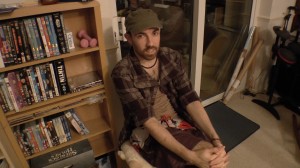
None of the problems we experienced “broke” the game, and we found our way to a reasonably-satisfactory conclusion. A majority of us voted correctly, determining the identity of the murderer, and Ruth even managed to identify an important twist (albeit not based on anything more than speculation: the “flash” was a little subtle for us). There were a few anachronisms in the script, but they’re of the kind that only nerds like us would notice (the National Theatre is mentioned despite the fact that it won’t be founded for another four decades or so, and a character makes a reference to a frozen turkey, even though freezing of meat in the West wasn’t yet commonplace, for example). We’d have really liked to have each had a brief – even just half a page! – to tell us each more about our own characters (their names, for example, as well some of the secrets that they might be concealing and any established relationships they have with other characters), and if we knew that Daggerville were adding this feature, it’d make us far more-likely to buy their products in future.
The short review would be: a few teething problems aside, we all had a wonderful time and we’d certainly consider a Daggerville game for our next murder mystery party. The characters were, on the whole, wonderful characters well-realised and fully-developed within the constraints of the genre, the twist was clever, there were moments of great hilarity (such as the point when we realised that there’d been a veritable conga-line of people stealthily following one another around the hotel), and the event built up to a fun and satisfying conclusion. I’d suggest that you all keep an eye on Daggerville in the future.
[spb_message color=”alert-warning” width=”1/1″ el_position=”first last”]Spoiler warning: reading beyond here could result in seeing spoilers. Don’t read on if you’re likely to ever take part in a game of The Ambassador’s Notebook.[/spb_message]
Aside from the lack of character “introductions”, another thing we found difficult in this game were issues in the script. The script for “The Neighbour” ended up one-number out of sync in the middle of Scene 2, where her ‘line 42’ indicated that a different person should be talking to what the rest of the scripts said. On another occasion, the script for “The Proprietress” seemed to be missing a line (although other characters had the ‘tail end’ of that line). The character of “The Journalist” can be played by a man or a woman, and although I selected “male” when I filled in the form, some of the scripts referred to the character as a woman! At first I thought that this might be related to difficulties some of us had had receiving the emailed scripts (Martin at Daggerville was incredibly helpful at sending out fresh ones, though), but we found at least one instance in which one person flip-flopped between referring to “The Journalist” as female or male!
(there’s a video I’ve put together of some of the highlights of our evening, but there’s possible spoilers in it)

Personally, though, my favourite moment of the night came right at the start, as we all introduced our characters. One of the Liz’s, an American, had decided to play her character as an American, and introduced herself as such. “Oh,” said the other Liz, whom she’d just met, “Are you going to do an accent?”